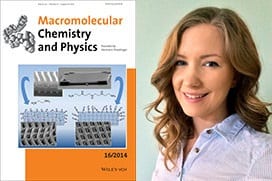Undergraduate Student Featured on Journal Cover
 A paper written by COS undergraduate Kaley Wilburn and co-authors is featured on the cover of the August 2014 edition of the peer-reviewed journal Macromolecular Chemistry and Physics. The students developed a new method for engineering chemical function into micro- and nano-scale devices that avoids distortions caused by conventional approaches.
A paper written by COS undergraduate Kaley Wilburn and co-authors is featured on the cover of the August 2014 edition of the peer-reviewed journal Macromolecular Chemistry and Physics. The students developed a new method for engineering chemical function into micro- and nano-scale devices that avoids distortions caused by conventional approaches.
Plastics are increasingly used to create low-cost micro- and nano-functional devices that can be used in medicine, sensors, and hand-held electronic devices. To obtain a response to a specific environmental stimulus, such as a chemical contaminant or a virus, micro-structures are commonly decorated with chemically active functional groups like DNA, proteins, or nanoparticles.
But processes for chemical attachment often involve small organic linking molecules and organic solvents, both of which are easily absorbed by plastics, causing the micro-structures to swell irreversibly and lose both form and function. The new approach employs large nitrogen-containing macro-molecules as linkers and reaction in water, both of which eliminate swelling.
To demonstrate the method, the team created plastic “woodpile” microstructures by nano-scale 3D laser printing and functionalized the surfaces using their chemical method. Scanning electron microscopy confirmed that the process not distort the structures. The activity of the surfaces was confirmed by depositing copper onto the structures, making them optically reflective and electrically conductive.
The new method could be used to create inexpensive micro- and nano-scale plastic devices for clinical applications, probes for environmental monitoring and remediation, and sensors for forensic applications.
The research team was mentored by Dr. Stephen M. Kuebler, Associate Professor of Chemistry and Optics. As stated by Dr. Kuebler, “I am particularly pleased with this result because we are all trying to encourage women in STEM careers, and co-author Kaley Wilburn did a great job with this.”
Kaley said: “The publication of this paper demonstrated to me how important it is to follow your curiosities if you are interested in science and research, even if it is relatively early in your academic career. As a freshman I was given the opportunity to assist on this project which far exceeded anything I’d done prior to joining Dr. Kuebler’s group, but by making it my goal to understand the intricacies a bit more every time I was in the lab, my appreciation for work that was initially foreign to me grew exponentially.”
Kaley’s work can be seen at Macromolecular Chemistry and Physics, Vol. 215, pp. 1533-1542 (2014) and online at:
http://onlinelibrary.wiley.com/doi/10.1002/macp.201470051/abstract
